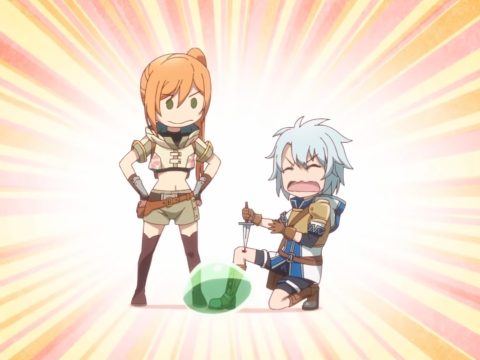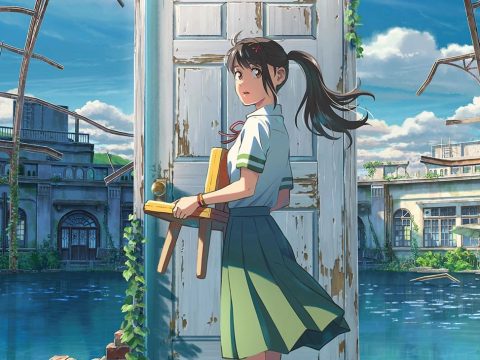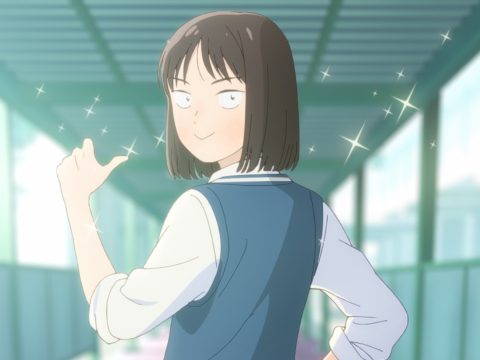Machine Logic
by
 Matt Alt
Matt Alt
November 2, 2007
Interview excerpted from the December issue of OTAKU USA]In spite of the success of his groundbreaking 2004 film Appleseed and the buzz surrounding the upcoming sequel, Ex Machina, Shinji Aramaki is quite possibly the most famous and influential anime insider you’ve never heard of.
If you’re a fan of anime robots and you haven’t heard of him, it’s time to start doing your homework. His robotic creations dominated Japanese airwaves in the early 1980s, redefining the way both anime fans and creators approached mechanical design. Aramaki’s signature design motif, motorcycles that transform into robotic exoskeletons and vehicles, were de rigueur accessories for many an 80s anime hero. Perhaps you’ve heard of some of them: the “Motoslave•bCrLf from Bubblegum Crisis. The “Garland•bCrLf from Megazone 23. And perhaps most famous to American fans, the “Ride Armor•bCrLf from Genesis Climber Mospeada, which aired in the States as the last third of the Robotech Saga. In between, he designed the “Deluxe Insecticons•bCrLf that appeared in Hasbro’s Transformers line, the transforming vehicles for the American Saturday morning cartoon M.A.S.K., and acted as a consultant on uncounted other anime and American cartoon shows. By the end of the decade, Aramaki’s reputation as the go-to guy for designing robots so tantalizingly realistic that they looked as though they might actually walk off the page was assured.
 In 2004, Aramaki unveiled his breakthrough film: Appleseed, a theatrical version of the post-apocalyptic Masumune Shirow manga considered by many virtually impossible to bring to the big screen. Aramaki’s well-honed design sensibilities allowed him to coax both a unique story from the densely plotted pages of the comic and a haunting beauty from the computers used to animate the film, breathing new life into a medium with an unsteady history for producing hits.Thanks largely to Appleseed‘s undisputed international success, Shinji Aramaki has stepped out from the shadows once and for all, redefining himself as a cutting-edge storyteller and the director of one of Japan’s hippest new anime series. Now he’s hatched a bold plan to take Japanese animation out of the “anime ghetto•bCrLf and to a much broader audience. Ex Machina, slated for US release later this year, features costumes by legendary fashion designer Miuccia Prada, a groovy electronica score by Japanese composer Hosono Haruomi and his pals from legendary synth popsters Yellow Magic Orchestra, and is produced by Hong Kong action maestro John Woo. It’s a collaboration with the potential for explosive international success, and makes Ex Machina feels less like your average anime flick and more like the shape of things to come.
In 2004, Aramaki unveiled his breakthrough film: Appleseed, a theatrical version of the post-apocalyptic Masumune Shirow manga considered by many virtually impossible to bring to the big screen. Aramaki’s well-honed design sensibilities allowed him to coax both a unique story from the densely plotted pages of the comic and a haunting beauty from the computers used to animate the film, breathing new life into a medium with an unsteady history for producing hits.Thanks largely to Appleseed‘s undisputed international success, Shinji Aramaki has stepped out from the shadows once and for all, redefining himself as a cutting-edge storyteller and the director of one of Japan’s hippest new anime series. Now he’s hatched a bold plan to take Japanese animation out of the “anime ghetto•bCrLf and to a much broader audience. Ex Machina, slated for US release later this year, features costumes by legendary fashion designer Miuccia Prada, a groovy electronica score by Japanese composer Hosono Haruomi and his pals from legendary synth popsters Yellow Magic Orchestra, and is produced by Hong Kong action maestro John Woo. It’s a collaboration with the potential for explosive international success, and makes Ex Machina feels less like your average anime flick and more like the shape of things to come.
I caught up with Mr. Aramaki in Tokyo’s Kichijoji ward, the birthplace of Japan’s anime industry. Less an interview and more like a freewheeling, several-hour discussion fueled by yakitori skewers and cold, cold Yebisu lager beers, read on as Aramaki regales us with tales of the glory days and reveals behind the scenes tidbits about his films past, present, and future.
Matt Alt: The first question I’d like to ask you is …
Shinji Aramaki: Yes?
Would you like a beer?
Sure.
You’ve had a long and storied career in the Japanese animation industry. First off, please tell our readers a bit about yourself. When did you first come to Tokyo, and what was the first production you worked on?
I was studying economics at Okayama University, but what I really liked to do was draw. A manga artist friend of mine told me there was design work in Tokyo. The toy company Takara was hiring freelance designers for their “Microman” series of toys. I submitted some sketches, and that’s how I got my start. This was around 1982. I was 21 at the time. My first job was “clean- up�VbCrLf work on transforming robot designs. Takara would give me the basic transformation pattern, and I would design the details and outer appearance of the robots, their faces and decorations. At first they were only sold in Japan, but two or three years later, many of these Microman toys became the basis for the Transformers series in the United States.
 Which Transformers did you work on specifically?
Which Transformers did you work on specifically?
•bCrLfSoundwave•bCrLf was mine • The cassette-player robot and its cassettes. This was the first time I’d ever worked with transforming robot toys, so Takara gave me a bunch of them to play with to get the hang of it. I worked on several others as well. There was a camera, a transforming camera that split into three smaller robots. That one was pretty much mine. And I came up with the idea for “Perceptor,•bCrLf a robot that transforms into a microscope. Actually, I was inspired by the scope-eyed robots in
Armored Trooper Votoms (1983), and initially I wanted to give it a face like the robots in that show. It ended up looking totally different, though. (Laughs)
Was that common? Basing your designs on other robots?
No, no. (laughs)What was the first anime production you worked on?
I did design work for Takara for about six months, and by that time I’d gotten to know the president of Artmic. Artmic wasn’t an animation company but rather a design firm. They created content, either in the form of designs for other companies or proposals for new anime shows that they would shop around to corporate sponsors. One day the president told me, “Since you can design robots, come up with a show proposal for me.” So I brought him the idea for Genesis Climber Mospeada, which was eventually picked up by a sponsor and broadcast the following year (1983). That was my first job at Artmic and in the anime industry.Can you tell me a little more about the genesis, no pun intended, of Genesis Climber Mospeada? It aired as part of the Robotech series in the 1980s, so it’s quite popular in the United States.
People always ask me where the idea for the Ride Armor, the transforming motorcycle, came from. It’s really simple. I’d just bought a motorcycle to get around after moving to Tokyo. I’d taken out a loan to afford it, and the monthly payment was 20,000 yen. That really killed me, and I thought it’d be cool to recoup my expenses by selling a design based on the bike. It occurred to me that the bike was roughly the right size for a rider to wear and walk around in, if it folded up somehow. That was the kind of thing on my mind back then. (laughs)What was it like working at Artmic?
The president was a former producer at Tatsunoko Productions, and was an accomplished artist in his own right. He painted a lot of the box art for all of the Macross and Mospeada models and toys, really finely detailed acrylic renderings of the various mecha. So he was a pretty unique sort of boss. He never rode his employees. He let us do pretty much whatever we wanted. We could show up whenever we liked or even not come to the office at all, so long as we got our projects done.
 It sounds more like an Internet start-up than a Japanese company!
It sounds more like an Internet start-up than a Japanese company!Yes! At any other company you’d get fired for that kind of thing! (laughs) And to top it off, he paid us real salaries. I liked him a lot. It was a great environment, and an amazing learning experience for me. In fact, because it was so open, I was able to take other projects from different companies to supplement my income. At one point I was going to another studio during the day and then coming to Artmic and working all night. I was young and the crazy schedule didn’t bother me.
Artmic was involved in quite a few American productions as well, weren’t they? Doing design work.
A couple of times I went to Los Angeles to talk to toy companies about various projects for Artmic. And after that, I was sent to Chicago by this Japanese animation company called DIC, which was working on a show for the American marketplace called
M.A.S.K.
M.A.S.K.! (1985). A classic of mid-80s American Saturday morning cartoon programming. Can you tell us a little about that?
Actually, M.A.S.K. is one of those times I snuck out of Artmic and worked for another studio during the day. (laughs) In fact, I even left the country! I told the president of Artmic I was going on break, and went to Chicago to discuss the designs of the toys and get prototypes approved. When I came back to Japan two weeks later, all he said was, “Man, you sure took a long vacation! Where were you?”I don’t think many Americans realize that show was at least partly designed in Japan. I certainly didn’t have any idea at the time. So Artmic gave you a lot of early experience in the anime and toy industries.
Artmic was only concerned with presenting ideas to sponsors, who would then hire another company to actually animate the show. It was mainly marketing and sales, pitching ideas to other production companies. I wanted to get more involved in the animation process, working in the studio drawing storyboards and things like that. By the time Artmic went out of business in the late 80s or early 90s, I knew I wanted to be a director. Working there was an amazing learning experience for me. I learned how to put a proposal together, how much budgets were, and which concepts got picked up and which didn’t. Mospeada is a perfect example. It wasn’t just design. Back then sponsors were basically all toy companies. You’d take sketches and a mock-up of a transforming robot and show it to them in a presentation. If they were like, “Wow!” and felt they could sell it as a product, the show would get the go sign. That’s the process in a nutshell.Still, it sounds pretty nerve-racking.
It was, but the flip side was that my opinions were taken very seriously in spite of my age. Mospeada was my very first animation project. And the first time something I designed was being made into a product. At this point in the development process I’d handed over all of my materials and their engineers had produced a prototype when I was called in for a meeting. When I showed up, what I think was supposed to be the Ride Armor was sitting in a heap of parts in the middle of the table; they just couldn’t figure out how to make it work. For half an hour, everyone just sat there staring at it and trying to figure it out. No matter how many times I explained it, I could practically see the question marks hanging over their heads. I was feeling stuck, because time was getting tight. This was early summer and the toy had to be on the shelves by the end of the year. The whole time I kept hearing these whispered conversations around the table about how it cost something like 50 million yen to make the molds and how many thousands of lots they would need to sell by the end of the year to break even and so and so. It all worked out in the end, because another one of their engineers, a really talented man, came on board and instinctively got what I was saying. Everything went smoothly from that point on, but … Anyway, I was only 22 or 23 and, quite frankly, couldn’t believe such a huge responsibility had been laid on my shoulders. (laughs)On that note, what do you think constitutes a good mechanical design? How do you go about the design process? Do you do a lot of research, or does the inspiration come from within?
I’ve always loved cars and motorcycles and machines like that. As a kid, even back in grade school, I’d spend my days drawing cutaway views of cars and their engines. That was just what I did. I didn’t have any sense that I was “designing” anything. My dad and older brother weren’t mechanics or engineers but they loved cars and planes. My dad took us to airports to see the aircraft, and in our spare time my brother and I used to take apart and rebuild motorcycle engines for fun. I grew up around mechanical things, and I loved to draw. I didn’t consciously decide to become a designer or anything. I just kept doing what I enjoyed doing. I think that’s really important. When I was young, all of the robots on TV, like Gundam (1979), looked cool, but I didn’t really get a sense of their mechanical inner workings. I didn’t sense the beauty of the engineering, how the mechanical parts all work together. I’m fascinated by the logic of machinery: where the engine is, what it connects to, that sort of thing. That’s the path I followed. It’s important to have passion for what you design.

You obviously take inspiration from real-world designs, though, like when you based the Mospeada Ride Armor off of your own motorcycle.
Right. Back then, road bikes had small front tires to improve cornering; they only came up to about my knees. They were very compact and I thought the parts would be a good fit for a human body if they were moved around a bit. Actually, the initial concept was that the bike should transform into a stand-alone robot, but then I thought it would be more interesting as a wearable suit for a soldier. So yes, I think it’s important to ground one’s designs in reality. The same thing is true for other mechanical designers as well, I think. [Mecha designer]
Shoji Kawamori obviously studied real-world fighter jets to come up with the Macross Valkyrie. In the early days a lot of robots transformed into crazy things that didn’t look like planes or anything in real life. For me, it’s more fun to take something everyone knows and make it transform into a robot.
What series have had the most influence on your style?
Like a lot of people in my generation, like
Hideaki Anno (
Evangelion) and Shoji Kawamori, first and foremost would have to be the
Space Battleship Yamato (aka
Star Blazers, 1974) series. I watched that in high school. And then right when I started college,
Mobile Suit Gundam came out (1979). Those inspired a lot of us to go into the industry.
So films like those made the anime industry seem “cool” in your eyes?
Cool isn’t the word … See, I loved real-life aircraft and cars. Up to that point I actually looked down on anime, because none of it was particularly realistic. As a kid I was even a little bored by it. But Yamato and Gundam changed my mind. You could tell the designers were inspired by real mechanical things, and it gave me a new sense of what could be done with the medium of animation. And right around the same time, I saw Star Wars for the first time. Star Wars is the big one for me. I wanted to make something like it, but I wasn’t interested in working for a Japanese special-effects company and didn’t particularly want to go to America. And so because I could draw, I decided to try working in the animation industry. Everyone knew Star Wars was a major hit in America but it took a year for it to come out in Japan. While I waited I assembled a small library of books, cards, and other merchandise for the film, so I’d built up a pretty clear idea of what the movie was about in my head before I even saw it. In fact, I was disappointed in spots because I’d imagined it playing out a little differently. (laughs) I must’ve seen it 10 times during its original release here.So Yamato, Gundam, and Star Wars, then. Anything else?
Another film that left a big impression on me was
Mad Max 2: The Road Warrior (1981). At the time I hadn’t even seen the first one. I was absolutely floored by that film. This was before anyone I knew owned a VCR, and so I took a boom-box to an all-night showing at my local theater way out in the countryside, sat it on the seat next to me, and recorded the entire thing on audiocassette. (laughs) It was kind of wrong, I know, but I listened to that tape constantly when I worked and studied.
Wow. In the age of DVDs and BitTorrent and YouTube and all of that, it’s hard to believe …
I know! But that’s all we had back then. Actually, I made an audio tape of another film as well, Lupin III: The Castle of Cagliostro (1979). I listened to that tape every single day. I had it memorized. I was still in college at the time and working this really boring, repetitive job to earn some pocket money, and to keep myself occupied I’d mutter the entire script to myself, line for line from memory, while I was cleaning or whatever. By the time I’d finished reciting it, two hours later, the job would be over. (laughs) I did the same thing with Star Wars, which ended up being a great resource for picking up a little English. So I didn’t watch a wide variety of films, but made up for it by watching or listening to the things I liked over and over again.
Did you try your hand at any drawing or writing at the time?
I remember trying to storyboard the trench scene from Star Wars from memory after seeing it the first time. Then I’d bring it back during subsequent showings and revise it as I watched the film. (Laughs)So the lack of technology actually helped you in a way.
I put a lot of effort into trying to replicate what I heard or saw on-screen. Looking back, I think it was actually excellent training. Because I had all of these scenes in my head, I could refer back to them whenever I was trying to write or draw my own original content.
Read the rest of Matt Alt’s interview with Shinji Aramaki in the current issue of OTAKU USA, on sale at book stores and newsstands now. And look for complete coverage of Aramaki’s new anime, Ex Machina, in the February issue of OTAKU USA, on sale December 4!
Share This Post
 In 2004, Aramaki unveiled his breakthrough film: Appleseed, a theatrical version of the post-apocalyptic Masumune Shirow manga considered by many virtually impossible to bring to the big screen. Aramaki’s well-honed design sensibilities allowed him to coax both a unique story from the densely plotted pages of the comic and a haunting beauty from the computers used to animate the film, breathing new life into a medium with an unsteady history for producing hits.Thanks largely to Appleseed‘s undisputed international success, Shinji Aramaki has stepped out from the shadows once and for all, redefining himself as a cutting-edge storyteller and the director of one of Japan’s hippest new anime series. Now he’s hatched a bold plan to take Japanese animation out of the “anime ghetto•bCrLf and to a much broader audience. Ex Machina, slated for US release later this year, features costumes by legendary fashion designer Miuccia Prada, a groovy electronica score by Japanese composer Hosono Haruomi and his pals from legendary synth popsters Yellow Magic Orchestra, and is produced by Hong Kong action maestro John Woo. It’s a collaboration with the potential for explosive international success, and makes Ex Machina feels less like your average anime flick and more like the shape of things to come.
In 2004, Aramaki unveiled his breakthrough film: Appleseed, a theatrical version of the post-apocalyptic Masumune Shirow manga considered by many virtually impossible to bring to the big screen. Aramaki’s well-honed design sensibilities allowed him to coax both a unique story from the densely plotted pages of the comic and a haunting beauty from the computers used to animate the film, breathing new life into a medium with an unsteady history for producing hits.Thanks largely to Appleseed‘s undisputed international success, Shinji Aramaki has stepped out from the shadows once and for all, redefining himself as a cutting-edge storyteller and the director of one of Japan’s hippest new anime series. Now he’s hatched a bold plan to take Japanese animation out of the “anime ghetto•bCrLf and to a much broader audience. Ex Machina, slated for US release later this year, features costumes by legendary fashion designer Miuccia Prada, a groovy electronica score by Japanese composer Hosono Haruomi and his pals from legendary synth popsters Yellow Magic Orchestra, and is produced by Hong Kong action maestro John Woo. It’s a collaboration with the potential for explosive international success, and makes Ex Machina feels less like your average anime flick and more like the shape of things to come. Which Transformers did you work on specifically?
Which Transformers did you work on specifically? It sounds more like an Internet start-up than a Japanese company!
It sounds more like an Internet start-up than a Japanese company!







